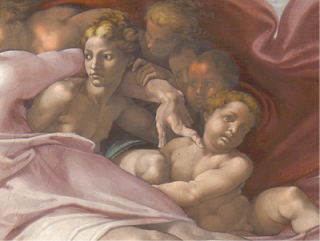The gospel reading for Christmas 1C (Luke 2:41-52) gives us the only story of the young Jesus in the canonical gospels. In the story, Mary and Joseph think that Jesus is traveling home with family members or friends, only to discover that he is nowhere to be seen. After searching "diligently" they find him in the temple, having theological conversation with the teachers there.
It is another of the stories that has probably lost some of its shock value over time. Of course the son of God would be disputing (one of the formal names for images of this subject is "The Disputation") with human teachers of faith. And yet the story - and images of it - have the power to raise conversation...and disputes.
German painter Max Liebermann created a painting of the subject exhibited at Munich's First International Art Exhibition in 1879. In the painting (below left), the young Jesus sits among the rabbis in a temple. The temple here is a combination of elements from synagogues that the artist visited as he was preparing the composition and subject. The curved staircase is a reference to the16th-century Levantine Synagogue in Venice. The paned window on the upper edge of the painting echoes the windows of the Portuguese Synagogue of Amsterdam, which the artist visited in 1876. His models for the rabbis were Christians and for the young Jesus an Italian boy, choosing these models to avoid the "danger of caricature." He did studies of the figures and exhibited the painting for the first time at the International Exhibition.


(Left) Max Liebermann. The Twelve-Year-Old Jesus in the Temple. 1879. Oil on canvas. Hamburger Kunsthalle. For the Hamburger Kunsthalle, see: http://www.hamburger-kunsthalle.de/index.php/home_en.html (Right) Liebermann. Study for The Twelve-Year-Old Jesus in the Temple. 1879. Crayon over Pencil. Kupferstichkabinett. Staatliche Museen zu Berlin. For the study, see: http://www.smb-digital.de/eMuseumPlus? service=direct/1/ResultLightboxView/result.t1.collection_lightbox.$TspTitleImageLink.link&sp=10&sp=Scollection&sp=SfieldValue&sp=0&sp=1&sp=3&sp=Slightbox_3x4&sp=0&sp=Sdetail&sp=0&sp=F&sp=T&sp=0
The painting was reviled. Liebermann's painting portrays a Jesus who was not a precocious theological talent outshining the Jewish scholars. Instead, what critics saw was, as art critic Friedrich Pecht wrote, "the ugliest, know-it-all Jewish boy imaginable." Pecht described the scholars as "a rabble of the filthiest haggling Jews." So outraged were German sensibilities that the painting and its creator were discussed in the German parliament, with the resulting opinion that perhaps future exhibition organizers would take an artist's religious sensibilities into consideration before exhibiting their work.
You see, Liebermann was Jewish. And in the third quarter of the 19th century, anti-Semitism was on the rise in Germany. The root of the problem was that Liebermann (a Jew) had painted a Jewish Jesus talking with rabbis who were listening to the child - perhaps not convinced by his argument but considering it. The usual approach to the subject was to contrast Jesus - a beautiful youth - with temple officials caricatured by gross and exaggerated features. As you consider the image here, though, you may be wondering about the uproar. In the years after the painting's premiere, the artist attempted to ameliorate the vicious comments by overpainting the figure of Jesus. The Jesus of the painting we see today is using his hands with restraint and has changed from a dark-haired boy into this blond-haired cherub. The drawing on the right is a preparatory sketch for the original composition.
Liebermann's approach was to include the most "real" persons, places and things in his telling of this story. For his efforts, Liebermann's painting was dismissed by critics like Anna Jameson in her book
Legends of the Monastic Orders (1900). Her assessment was that Liebermann (and several of his contemporaries who shared his approach) had "translated into uninteresting prose an incident which belongs essentially to the realm of poetry." For the painting's original audience, it wasn't enough for Jesus to be shown as a 12-year-old boy who was listening, asking questions and amazing adults with his understanding and answers. Even though that is how Luke's gospel describes the event.
Max Liebermann resigned (before he could be dismissed) from his position as president of the Prussian Academy of Arts in 1933 because the Academy could/would not exhibit work by Jewish artists. Liebermann died in 1935. In 1940 his widow was forced to sell (to the German government) the Liebermann summer residence, a villa in the Berlin suburb of Wannsee. The Liebermann villa is only a hundred yards from the villa where the Nazis held their infamous Wannsee Conference - where the subject was Hitler's "final solution". After which there was, jumping to an echo of the Bethlehem of Matthew's gospel, the sound of Rachel weeping for her children.
For the Levantine Synagogue, see: http://jvenice.org/en/levantine-synagogue
For the Portuguese Synagogue, see: http://www.portugesesynagoge.nl/eng
On the Art&Faith Matters Facebook page, see this version of the Nativity. Click
here.
For additional thoughts on Luke 2:41-52, click
here.










